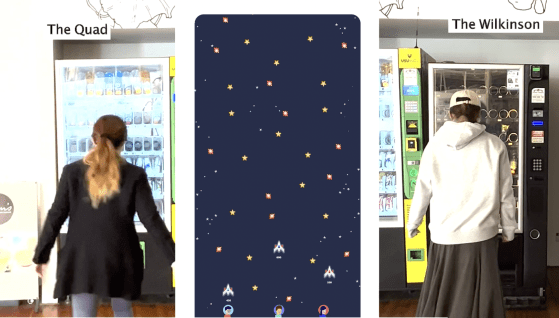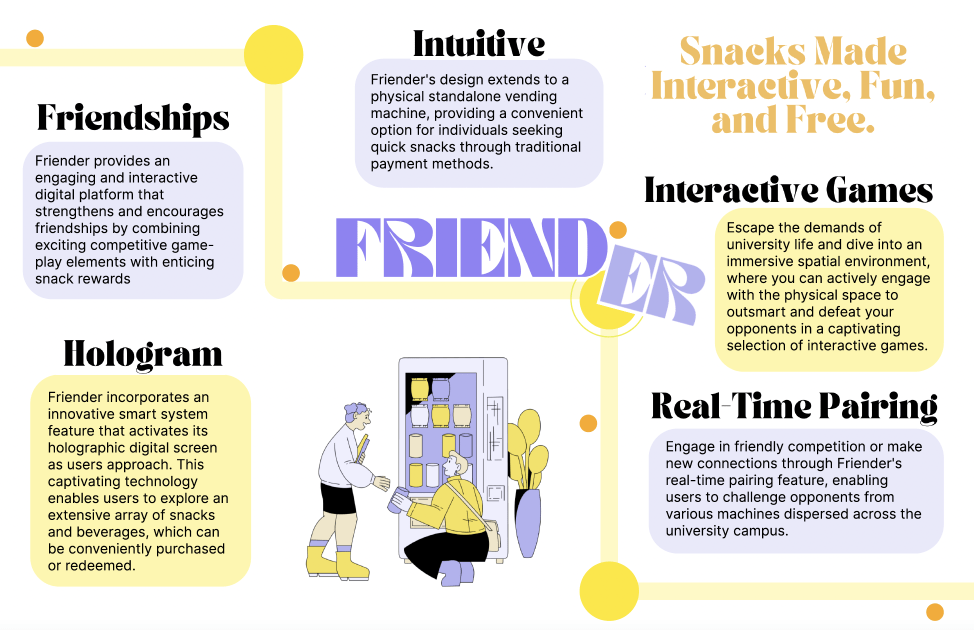Social Interactive Vending Machine - Friender

Background
The Friender project was the outcome of our semester-long effort to improve the social well-being of university students. Through a series of four assignments, including a case study, solution ideation, mid-fidelity prototype presentation, and hi-fidelity prototype and poster development, we developed the Friender prototype. These assignments allowed us to deeply understand the challenges students face and generate effective solutions. The iterative process enabled us to refine the prototype based on user feedback and expert guidance, resulting in a valuable tool to enhance the social well-being of university students.
User Research
In this assignment, our focus was on understanding the shared challenges experienced by our target group: university students on campus. Through extensive research, we identified that physical, mental, and financial well-being are interconnected with social well-being among students.
To gain insights into these aspects, we employed three research methods: questionnaires, mapping space, and online ethnography. Questionnaires allowed us to gather quantitative data and gather a broad understanding of students’ experiences. Mapping space helped us visualize and analyze the physical environment, identifying key areas and patterns. Online ethnography enabled us to delve deeper into students’ thoughts, behaviors, and interactions within the digital realm.
During the final stage, we synthesized the diverse insights gathered from these research methods. By systematically organizing and categorizing the collected information, we identified main categories that highlighted key insights. This synthesis process allowed us to extract meaningful findings and patterns, shedding light on the challenges and needs of university students in relation to their overall well-being and social interactions on campus.
Ideation & Mid-Fidelity Prototype
Throughout this assignment, we engaged in several ideation sessions, considering multiple ideas and options. However, using the Team Decision Matrix method, we carefully evaluated and eliminated certain concepts, ultimately selecting the most promising one that aligned with our refined problem statement.
After reflecting on a comprehensive case study, we identified a clear problem statement: “Students at USYD feel uncomfortable and out-of-place on campus due to unfamiliar landscapes and environments, and they need a more accessible means of social interaction.” This refined problem statement guided our ideation process, leading us to choose an idea that directly addressed this challenge.
From there, we proceeded to develop the mid-fidelity prototype based on the selected concept, incorporating features and functionalities aimed at facilitating social interactions and alleviating the discomfort experienced by students in the unfamiliar campus environment.
This is the poster for the hi-fidelity prototype

This is the hi-fidelity video prototype

Hi-Fidelity Prototype & Poster
This marked the culmination of our project, where we took the valuable user feedback and input from our tutor to enhance the prototype. Building upon the mid-fidelity version, we made significant refinements to create a high-fidelity prototype. To showcase its advanced features, we opted for a video prototype, incorporating the captivating holographic element. Furthermore, we incorporated the key insights gleaned from the mid-fidelity phase, such as introducing a game mode for more than two players and prioritizing skill-based games as a superior choice.

